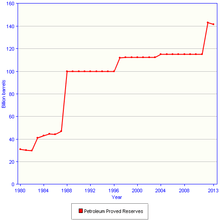Oil reserves in Iraq
Oil reserves in Iraq are considered the world's fifth-largest proven oil reserves, with 140 billion barrels.[1][2] The sources for this oil is primarily located in the Shiite Muslims-majority and Arab Sunni Muslims-dominated areas on the other hand are comparatively lacking.[3]

---2017---US-EIA---Jo-Di-graphics.jpg)
As a result of military occupation and civil unrest, the official statistics have not been revised since 2001 and are largely based on 2-D seismic data from three decades ago. International geologists and consultants have estimated that unexplored territory may contain vastly larger reserves. The majority of Iraq's proven reserves of oil comes from the following cities: Basra (Being #1), Baghdad (Being #2), Ramadi (Being #3), and finally, Ba'aj (Being the last oil rich city).[4]
A measure of the uncertainty about Iraq's oil reserves is indicated by widely differing estimates. The U.S. Department of Energy (DOE) estimated in 2003 that Iraq had 112 billion barrels (17.8×109 m3). The United States Geological Survey (USGS) in 1995 estimated proven reserves were 78 Gbbl (12.4×109 m3). Iraq's prewar deputy oil minister said that potential reserves might be 300 Gbbl (48×109 m3). The source of the uncertainty is that due to decades of war and unrest, many of Iraq's oil wells are run down and unkept. Repairs to the wells and oil facilities should make far more oil available economically from the same deposits. Iraq may prove to contain the largest extractable deposits of oil in the entire Middle East once these upgrading and facility improvements have advanced.[5]
After more than a decade of sanctions and two Gulf Wars, Iraq's oil infrastructure needs modernization and investment. Despite a large reconstruction effort, the Iraqi oil industry has not been able to meet hydrocarbon production and export targets. The World Bank estimates that an additional $1 billion per year would need to be invested just to maintain current production. Long-term Iraq reconstruction costs could reach $100 billion or higher, of which more than a third will go to the oil, gas and electricity sectors. Another challenge to Iraq's development of the oil sector is that resources are not evenly divided across sectarian lines. Most known resources are in the Shiite areas of the south and the Kurdish areas of the north, with few resources in control of the Sunni population in the center.
In 2006, Iraq's oil production averaged 2.0 million barrels per day (320×103 m3/d), down from around 2.6 Mbbl/d (410×103 m3/d) of production prior to the coalition invasion in 2003.[4] Iraq's reserve to production ratio is 158 years. After the end of the invasion the production increased on a high level, even though there is an invasion from the so-called ISIL the production in March 2016 stood at 4.55 million barrels a day. Which seems to well become a new all-time peak year for Iraq if OPEC talks about freezing or reduce production held in April 2016 will not lead to a reduction. The old peak was 1979 with 171.6 million tons of oil compared to 136.9 million tons produced in 2011 and 152.4 million tons in 2012.[6][7]
Oil extraction contracts awarded
2009
On June 30 and December 11, 2009, the Iraqi Ministry of Oil awarded contracts to international oil companies for some of Iraq's many oil fields. The winning oil companies entered joint ventures with the Iraqi Ministry of Oil, and the terms of the awarded contracts include extraction of oil for a fixed gain of $1.40 per barrel for the oil companies with the remainder going to Iraq.[8][9] The fees will only be paid once a production threshold set by the Iraqi ministry of oil is reached.
Oil fields contracted include the "super-giant" Majnoon Field, Halfaya Field, West Qurna Field and Rumaila Field. The East Baghdad Field, situated in part under Sadr City, did not receive any bids and the Iraqi oil ministry is considering working the field itself. Oil minister Hussein al-Shahristani told Iraqi public television that the increasing oil production "would finance infrastructure projects across Iraq - schools, roads, airports, housing, hospitals".[9]
See also
References
- "International Energy Statistics". Eia.gov. Archived from the original on 2017-04-27. Retrieved 2017-04-24.
- "OPEC Share of World Crude Oil Reserves". OPEC. Archived from the original on 10 January 2015. Retrieved 11 January 2015.
- "27 maps that explain the crisis in Iraq". vox.com. Archived from the original on 1 June 2016. Retrieved 26 April 2018.
- "Iraq Oil". Country Analysis Briefs. US Energy Information Administration. 2007. Archived from the original on 2008-05-09. Retrieved 2008-04-27.
- Gal Luft (2003). "How Much Oil Does Iraq Have?". The Brookings Institution. Archived from the original on 2017-04-25. Retrieved 2017-04-24. Cite journal requires
|journal=(help) - "Iraq oil output hits record high ahead of production freeze talks". rt.com. Archived from the original on 25 April 2016. Retrieved 16 April 2016.
- "statistical review of world energy 2013" (PDF). British Petroleum. Archived (PDF) from the original on 31 January 2016. Retrieved 16 April 2016.
- "Oil firms awarded Iraq contracts". Al Jazeera English. Archived from the original on 13 May 2011. Retrieved 11 January 2015.
- "BP group wins Iraq oil contract". Al Jazeera English. Archived from the original on 6 September 2011. Retrieved 11 January 2015.
